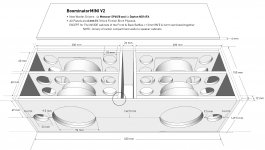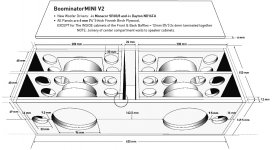Please be so kind to do a comparison between this MINI and a ported 3.25L per driver version. Thanks!
They'll be more or less the same. The closed version will have higher cone excursions but not more than the driver can handle.
The theory is that a BR tuning have a theoretical bass boost of 100% (double the output) while a capacitor resonated closed box tuning have a theoretical 44% bass boost. However, in actual numbers the potential bass boost of a BR tuning is around 73% at best and effectiveness drops as drivers and cabinets are smaller. The CRCB tuning on the other hand remains equally effective at around the theoretical potential. It's in principle if designed correctly only limited by the ESR of the series capacitor and how air tight the box is but even the latter will only marginally impact potential if it is incorporated in the calculation of the series capacitor.
So why chose a CRCB tuning? Well, as said above it's not much less effective than a BR tuning in very small boxes. And at the same time the capacitor also attenuates the output in the sense that it has a boost at the resonance followed by a dip of half the boost at roughly 3 times the resonance which is excellent as that is where we have a peak from the closed box tuning. So it will have an almost completely flat response to about 90hz. And it allows for a box that it half the volume.
Q is at the same time lower so it will be more suited for dual purpose, indoor and outdoors, as it will not exhibit a too flabby bass indoors, and neither lack bass fullness outdoors.
The theory is that a BR tuning have a theoretical bass boost of 100% (double the output) while a capacitor resonated closed box tuning have a theoretical 44% bass boost. However, in actual numbers the potential bass boost of a BR tuning is around 73% at best and effectiveness drops as drivers and cabinets are smaller. The CRCB tuning on the other hand remains equally effective at around the theoretical potential. It's in principle if designed correctly only limited by the ESR of the series capacitor and how air tight the box is but even the latter will only marginally impact potential if it is incorporated in the calculation of the series capacitor.
So why chose a CRCB tuning? Well, as said above it's not much less effective than a BR tuning in very small boxes. And at the same time the capacitor also attenuates the output in the sense that it has a boost at the resonance followed by a dip of half the boost at roughly 3 times the resonance which is excellent as that is where we have a peak from the closed box tuning. So it will have an almost completely flat response to about 90hz. And it allows for a box that it half the volume.
Q is at the same time lower so it will be more suited for dual purpose, indoor and outdoors, as it will not exhibit a too flabby bass indoors, and neither lack bass fullness outdoors.
Last edited:
Just to clear things up. The above sketchup is for the MINI with 4x monacor sp60/8 and 4x dayton nd16fa. The MICRO is the same drawing. Just only take one side just like a halfinator. In that case you use 2x monacor sp60/4 and 2x dayton nd16fa. Filters are the same or different depending on how you chose to connect it but more details on that to follow.
Thanks for the fast reply. Have you done actual measurements or listening tests? Seeing this thread: http://www.htguide.com/forum/showthread.php?39990-Capacitor-loading-a-woofer-in-a-small-box, the bass extension doesn't seem to be that large.
If I plot both in WinISD then the ported version has an f0 of 110Hz and the sealed version has an f0 of 160Hz. You think that with a simple cap we can gain 70Hz in bass response? Seeing the results in the linked thread, that seems difficult to achieve don't you agree? I hope I am wrong because then I can make my next boombox even smaller!
Edit: regarding the mini/micro, I got that. Personally I will be making a boombox with 2 woofers, so the micro. I just have to choose between sealed/cap and ported.
If I plot both in WinISD then the ported version has an f0 of 110Hz and the sealed version has an f0 of 160Hz. You think that with a simple cap we can gain 70Hz in bass response? Seeing the results in the linked thread, that seems difficult to achieve don't you agree? I hope I am wrong because then I can make my next boombox even smaller!
Edit: regarding the mini/micro, I got that. Personally I will be making a boombox with 2 woofers, so the micro. I just have to choose between sealed/cap and ported.
Last edited:
You think that with a simple cap we can gain 70Hz in bass response? Seeing the results in the linked thread, that seems difficult to achieve don't you agree?
No.
You're forgetting the acoustically filtered response from the opposite mounted driver.
EDIT: Besides, I got totally different numbers. f-3 at 109hz before cap is added. Undersized cap and bipolar response addition, f-3 at 89hz. 20hz deeper and all that is needed.
EDIT: Besides, I got totally different numbers. f-3 at 109hz before cap is added. Undersized cap and bipolar response addition, f-3 at 89hz. 20hz deeper and all that is needed.
Last edited:
This is my plot in WinISD:
https://drive.google.com/file/d/0B1MWms6QmN40aGxfbFU5U0lmN0k/edit?usp=sharing
I'm using a volume of 2.7L from your sketchup file.
SP60-4ohm
https://drive.google.com/file/d/0B1MWms6QmN40aGxfbFU5U0lmN0k/edit?usp=sharing
I'm using a volume of 2.7L from your sketchup file.
SP60-4ohm
I'm using the actual effective volume, 3.3L, when stuffing is considered. Also you might be calculating the volume of the drivers wrong due to them only being placeholders to show the outer dimension, not how much the drivers actually take up in volume. Also, have you considered the volume of the holes (it's 0.1L)?
Last edited:
With 3.3L I'm still only getting an f3 of 124Hz directly from WinISD. Maybe due to 4/8ohm driver specs? Or are you not talking about the WinISD value but an already adjusted value?
BMINI Dimensions
I also did a quick dimensions diagram I thought I would share, while I anxiously await the details of the MINI's new filters.
View attachment Boominator MINI V2.pdf
I also did a quick dimensions diagram I thought I would share, while I anxiously await the details of the MINI's new filters.
View attachment Boominator MINI V2.pdf
Attachments
I've looked before and couldn't find anywhere to get the Monacor drivers in the USA or Canada.
Somewhere (perhaps in this thread?) it appeared that Maxamp was going to start carrying the drivers for the new Mini, so might be able to get their amp and drivers at the same time.
Otherwise we should encourage PE, Solen, Meniscus, Madisound or someone to carry the Monacor. Tweets are available from PE and Solen...
Somewhere (perhaps in this thread?) it appeared that Maxamp was going to start carrying the drivers for the new Mini, so might be able to get their amp and drivers at the same time.
Otherwise we should encourage PE, Solen, Meniscus, Madisound or someone to carry the Monacor. Tweets are available from PE and Solen...
LAME! I got a woodworking bro with the tools and I can definitely build the crossovers and do the amp and wiring now. But without a local US source for drivers it aint gonna happen. Cannot pay that much for shipping and all...
Yep, I have received the woofers a few days ago, will add them asap 🙂. I wonder who is going to be the first one to finish a mini 😎
Wesley, can you provide some idea of the shipping cost to N. America. Say for a Maxamp and the Monacors, to K1B 3B5 in Ottawa, Canada.
Thanks!
Thanks!
Couple of questions:
How do you calculate bipolar response? What is the best way to mount the SP60's; bolt and nut, screws? Which and how many stuffing is needed. What are the XO specs?
How do you calculate bipolar response? What is the best way to mount the SP60's; bolt and nut, screws? Which and how many stuffing is needed. What are the XO specs?
If one were to use a mini-dsp or equivalent would the cap boost be not needed? as the equivalent adjustment could be done in software. Just checking as you guys know all of the black magic that is audio design lol?
- Home
- Amplifiers
- Class D
- The Boominator - another stab at the ultimate party machine


